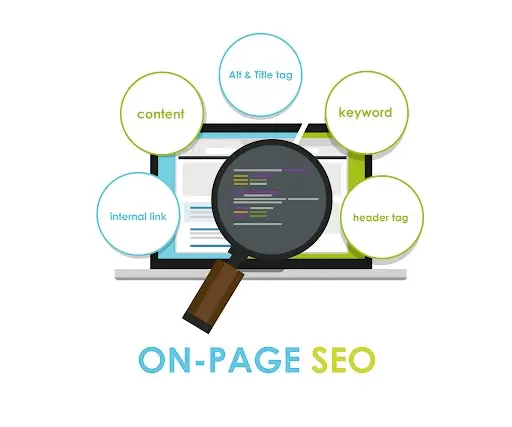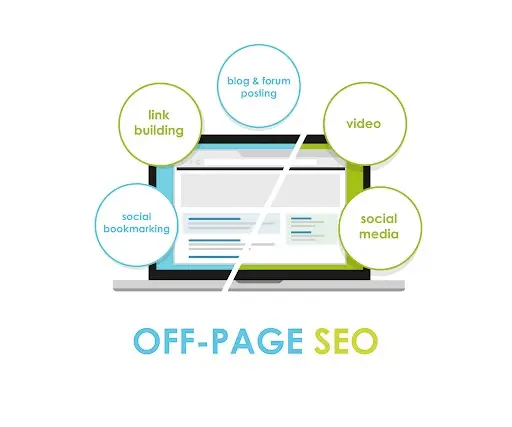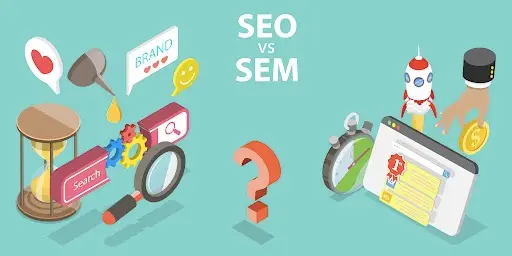Search marketing is one of the most necessary forms of marketing your business in today’s digital age. Search marketing refers to any tool or tactic that can help get your business noticed on the search engine results pages (SERPs), either by paid advertising or by ranking your pages amongst the top results.
Search marketing is divided into two major categories, SEO and SEM. Search engine optimization (SEO) uses organic strategies to gain visibility on SERPs. Search engine marketing (SEM) uses paid strategies to drive more traffic to your website. These tactics may seem similar, but they are two very different approaches to increasing search visibility.
What is SEO?
SEO marketing utilizes organic tactics to gain more visibility on SERPs and drive more traffic to your site naturally, without paid advertising. When businesses decide to use SEO strategies, they may pay third parties for strategic tactics but not for placement on the SERPs. There are many ways to enhance your business’s SEO presence, but using a combination of tactics will prove to be the most effective.

On-Page SEO
When you optimize your business’s website and make it SEO-rich, that is on-page SEO. This includes publishing new blogs, updating title tags, and ensuring that each page is relevant to its intent and main topic. You have control over your on-page SEO, and it’s essential to ensure that you stay up to date with your content since Google’s algorithms are constantly changing.

Off-Page SEO
Off-page SEO refers to the strategic efforts outside of your website, such as optimizing your social media pages, sharing content, or creating off-page articles. Some control comes with off-page SEO, but not as much as on-page optimization.
What is SEM?
Search engine marketing uses paid tactics and advertising to gain attention on SERPs. SEM usually includes paid strategies as well as SEO tactics to gain visibility effectively. There are different options when it comes to paid advertising, but the most common kind of paid search is pay-per-click (PPC) marketing. PPC ads allow the business to allocate a budget only once a consumer clicks on the ad and becomes a potential customer.
Google Ads is another form of paid search that requires businesses to conduct their own keyword research and target the best keywords for their specific industry. Then once consumers search for that particular keyword phrase, they will see your custom ad at the top of the SERP. The brand is only charged if the consumer clicks on the ad.
SEO vs. SEM: The Similarities and Differences
When determining which search marketing strategy works best for your brand, you should understand the similarities and differences between SEO and SEM.
The Similarities
Both SEO and SEM will help brands appear in search results and gain more visibility. When preparing strategies for SEO or SEM, both require knowing your audience and competitors to drive more traffic to your website. Effectively performing keyword research and using the data to curate content or ads that target specific keywords is also part of SEO and SEM strategies. Both categories of search marketing require continual testing and optimization because of the constant changes in Google’s algorithms.
The Differences
For SEM, you pay every time a user clicks on your ad, and your ads are only shown to a select target audience. SEO takes time and adds value over time, while the impact of SEM may be immediate or happen very quickly. If you can get your content ranked towards the top of the SERP, SEO has a higher click-through rate (CTR) than SEM.
When to Use SEO or SEM
When deciding whether SEO or SEM tactics may work best for your business, it’s important to compare how long it will take for you to see the kind of results you need. SEO can take a long time, especially if your website is new and doesn’t contain several backlinks. If your business utilizes SEO best practices and continuously optimizes each page, you will begin to see results within the first three to six months. On the other hand, SEM paid advertisements work very quickly, and you can start to see results almost immediately. Still, it will take effort to test the PPC to ensure that you are receiving continuous results. Despite the quick results of SEM, SEO can ensure long-term success. If you need to generate traffic and leads immediately and can’t wait for the results that come with SEO, SEM may be the best fit for your brand.
Combining SEO and SEM strategies can also be beneficial for your business. This powerful approach helps you own the most real estate on the first page of Google’s search engine results page. This blend of strategies will produce a robust digital marketing campaign and drive more traffic to your website. SEO targets upper-funnel leads while SEM targets bottom-funnel leads, so by creating a digital marketing strategy that includes both SEO and SEM, you can grow your client base.
Whether your business is small or big, it’s essential to have the correct search marketing strategy for your brand. It’s critical to drive traffic to your website to gain attention and grow your business, so it’s necessary to understand whether SEO or SEM strategies would work better. Regardless of which strategy you think is best for your brand, it’s crucial to enhance your digital marketing strategies and continuously optimize your pages.









